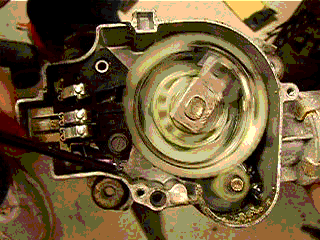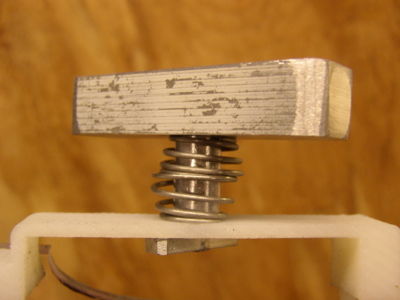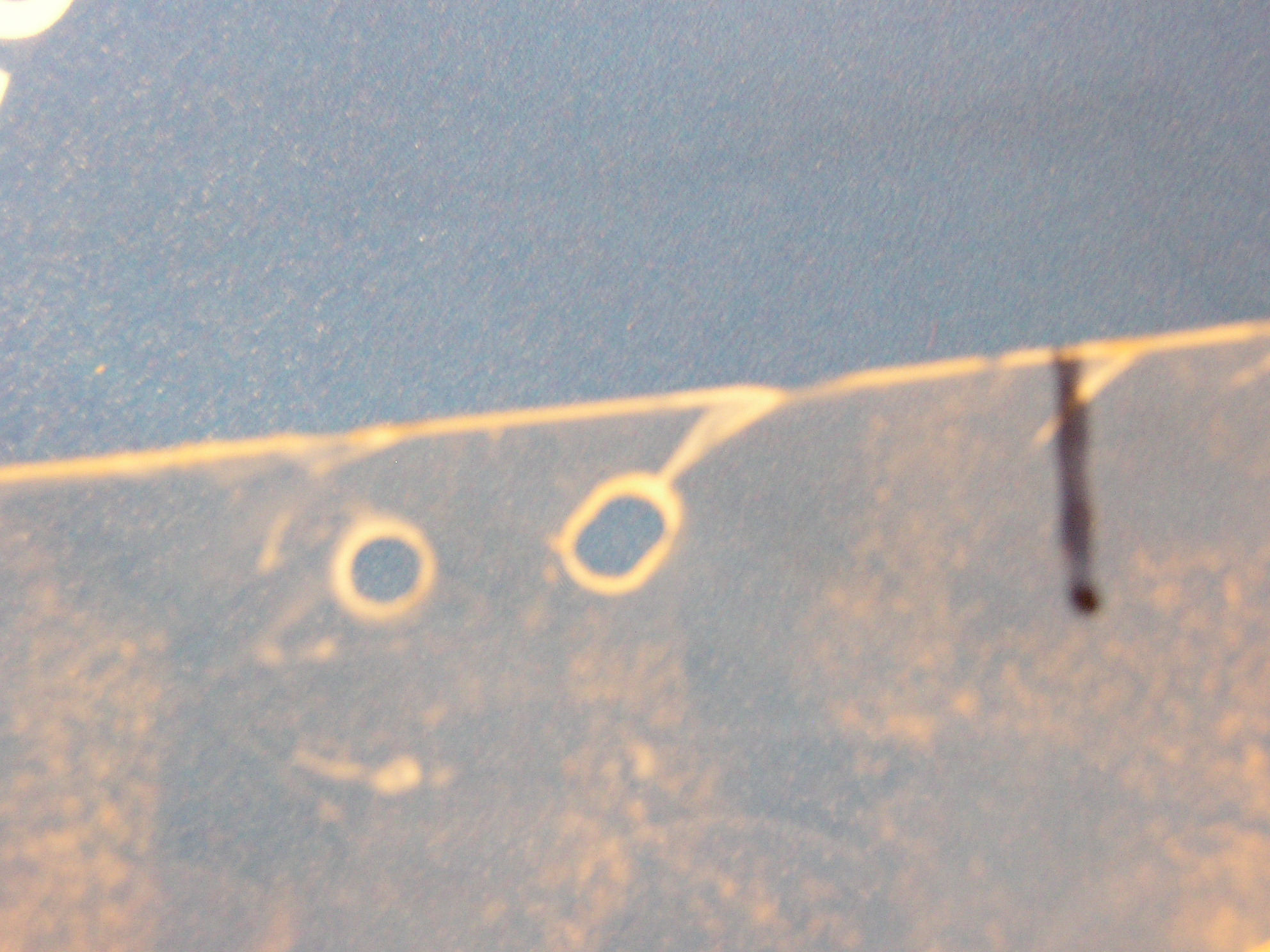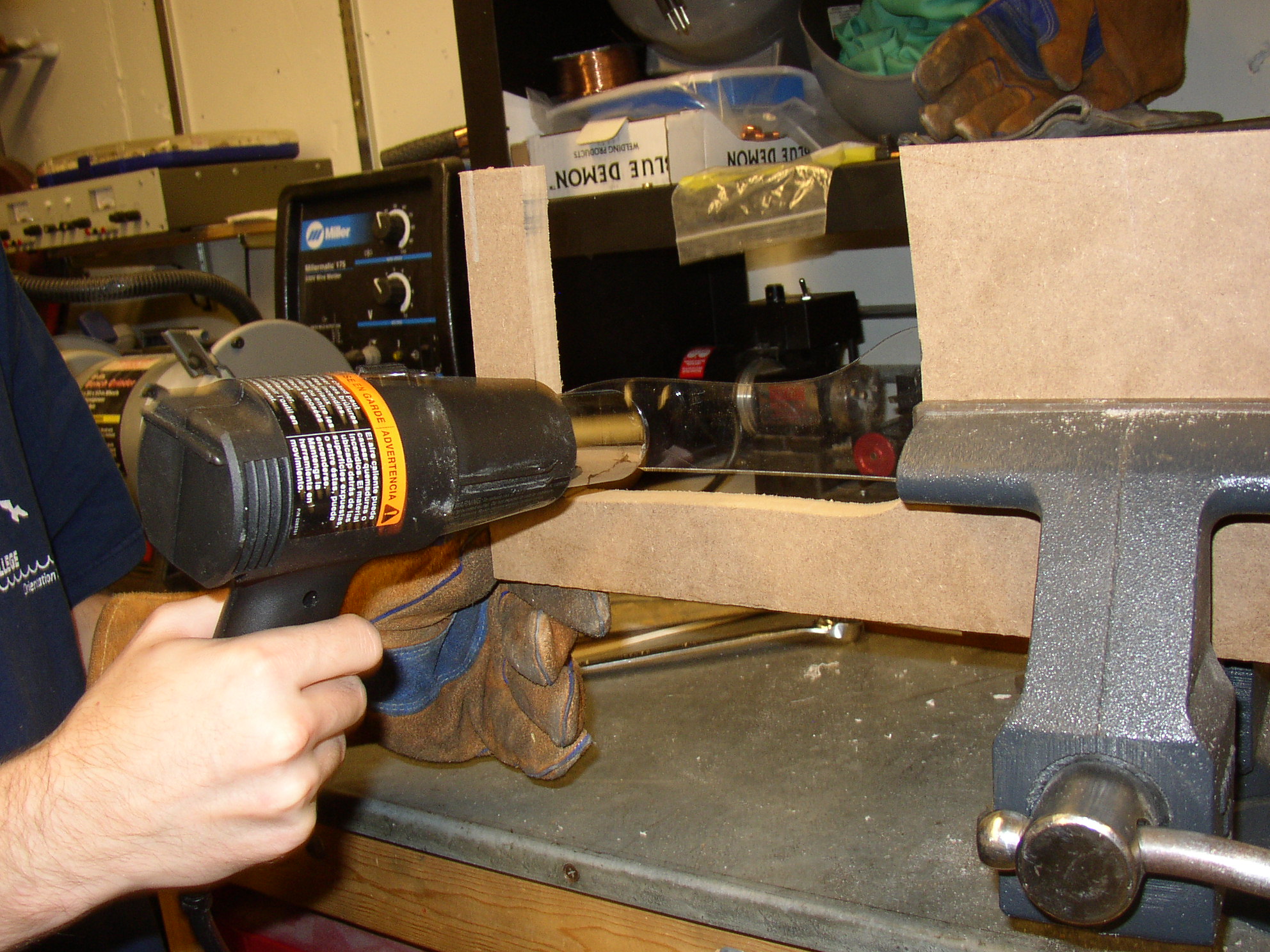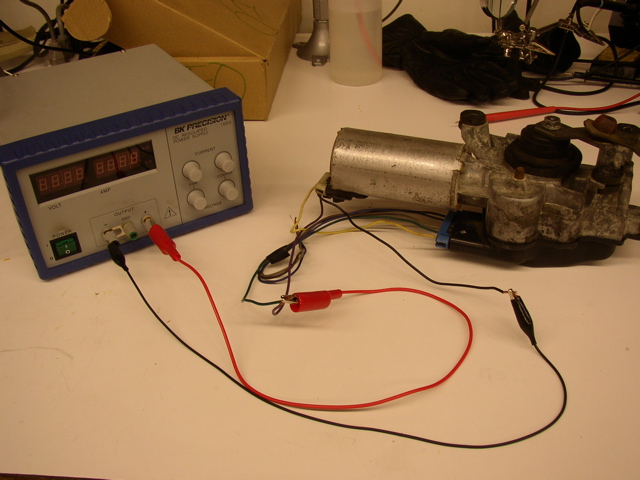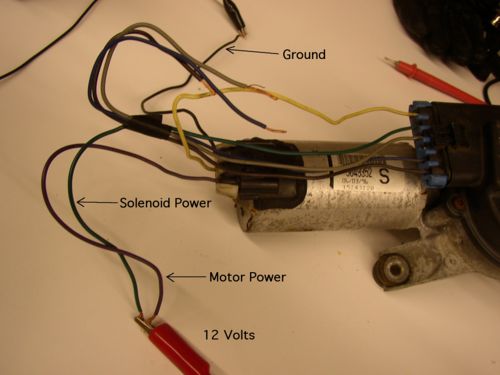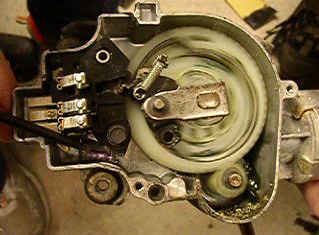Removable windshield scraper blade
From DDL Wiki
(→QFD) |
(→QFD) |
||
| Line 376: | Line 376: | ||
- A QFD to show (at minimum) the quantifiable engineering targets you have set for the design, relationships between engineering specs and stakeholder needs, and benchmarking of competing products. As always, explain your conclusions, such as what strengths your design has over competitor products and who is likely to buy it. | - A QFD to show (at minimum) the quantifiable engineering targets you have set for the design, relationships between engineering specs and stakeholder needs, and benchmarking of competing products. As always, explain your conclusions, such as what strengths your design has over competitor products and who is likely to buy it. | ||
| - | [[Image:Hoq.JPG]] | + | <center>[[Image:Hoq.JPG]]</center> |
== Final Prototype == | == Final Prototype == | ||
Revision as of 00:11, 10 December 2007
Final Report DUE DEC 7th* - ONE PER TEAM
- Will be accepted up to Dec 11th < midnight
SUBMIT AS WORD, PDF, OR WIKI PAGE
In your final report, you are looking to 1) provide evidence and make a case to support the need for your new design; 2) provide documentation necessary to fully describe and define the detailed design for production; and 3) use engineering analysis and your prototype to demonstrate feasibility of the design. Each team should document any information needed to accomplish the above objectives. To help you avoid forgetting anything major, a minimum requirements checklist will include:
Contents |
Executive Summary
The following document contains a report on a new product design. The purpose of this report is to analyze a windshield wiper system and come up with an improvement to this product. More specifically, we purchased the windshield wiper system of a ’96 Corsica and designed our product around that model. Windshield wipers are mainly used by customers for removing precipitation from the windshield so as to increase driving visibility and safety. Due to the fact that the primary purpose of this product is safety, it is important for the product to be reliable and functional. Ease of use is also a high priority because of quick-think situations that customers may find themselves in. Lesser in importance are maintainability and cost.
In the initial stages of our analysis we took apart our product to examine the way it works, get a part count, look closely at the DFMA aspects of it, and determine what could be improved. Based on the analysis of the DFMA of the current product, it seems to have already gone through a DFMA process. One area of improvement would be to standardize the parts, as most of them are unique.
After analysis we had a better understanding of how our product worked mechanically and how it was put together. We next did some brainstorming along with market research to come up with areas that the product could be improved or places where a new product could be made. Based on the market research we found that people were most concerned with leaves getting stuck under the wipers, the blades being ineffective in the winter, the disposal system of the blades not being environmentally friendly and the blades not lasting long enough. Per these top concerns we came up with the four best designs out of all of our ideas.
The first is heated blades, in which the blades of the wipers would be heated for easier snow and ice removal. The second is easily removable blades, in which the rubber part of the blade is made to snap into the wiper so that exchanging them is easier and more environmentally friendly. The third is a compressed air system that would eliminate blades all together and would be very good at removing leaves and other loose debris from the windshield. The final is a multiple-blade system that would incorporate both a rubber wiper for rain and a hard plastic scraper for removing snow and ice. After doing some analysis of each we decided to go with the multiple-blade design.
Background
Windshield wipers are used to wipe precipitation and dirt off of a windshield. Legally all cars are required to be equipped with windshield wipers. They are also commonly found on other transportation vehicles such as buses, trains, ship, and aircrafts. Visibility in inclement weather is dependent on the windshield wipers, thus it is important that they be reliable and safe.
Windshield wipers are powered by an electric motor. There is generally a four-bar mechanism which causes the windshield wipers to move in the wiping motion. A small number of systems, usually associated with vehicles that use air brakes, use air powered motors to power the wipers.
Market Research
- A clear statement of the opportunity you have identified, and documentation of market research to support the need.
The need that we found was for people to have a way to get ice off there windshield with out having to be outside scrapping it. We found that there where no other products designed around this purpose. This is what we saw as our opportunity to fill a niche that was clearly not being meet. We felt that if an effective deign could be made people would buy the product because of the near universal distance for standing out side in the cold while scrapping ice off your windshield.
When trying to decided if the windshield scrapper idea that we came up with would be something that people would actually want to buy we decided to sample the people we knew to get there reaction to design idea. We each contacted 5-10 and between the four of us only one person didn’t like the idea. There were however several people that had reservation mostly having to do with how easy it would be to attach and how quickly it would get ride of the ice.
When we were trying to decided on what kind of attachment we should make between the wipers and our blade we thought it would be time to do some more market research on what most people’s windshield wiper blades look like. What the problem boiled down to was did a great enough percentage of people’s wiper blades have holes on top and a recess that we could justify the use of a permanent attachment part that utilized these holes. To get a good cross section of what our target demographic (having plenty of disposable income and like gadgets) had on there car we started out in CMU’s parking lot and surveyed the cars, it also couldn’t hurt that CMU is ranked very high for out of shape campuses. We found rather favorable results most cars windshield wipers had holes in there wipers. Then we decided to expand our sample to include cars parked in the Pitt university area and found similar results. In the end we sampled more then a hundred cars and found when all was tallied up the result was 1 to 13 in favor of holes.
INTERVIEW WITH MARGARET SHOLTZ, PRODUCT TESTEE.
[13:05] CalcBanditCMU: ok...so, overall, what was your impression of the product?
[13:05] mag: umm
[13:05] mag: I thought that it was very efficient at pushing the snow off my windshield
[13:07] CalcBanditCMU: were you satisfied that the design could be installed and used on your car without damaging your windshield or windshield wipers?
[13:07] mag: yes
[13:07] CalcBanditCMU: comment on the weight of the detachable portion
[13:07] mag: it was very light
[13:08] CalcBanditCMU: do you think this product would be useful for scraping ice off of a windshield?
[13:09] mag: I think it would be better than using my wipers for getting the ice off the windshield [13:09] mag: possibly a little better if the edge was thin and sharp
[13:10] CalcBanditCMU: comment on the ease of attachability and detatchability of the scraper to the mounted blocks
[13:10] mag: it takes under a minute
[13:11] CalcBanditCMU: if you owned these scrapers, would you prefer to attach them, run your windshield wipers from your car, and detach them, or would you rather use a traditional hand held scraper to clear your windshield?
[13:12] mag: if the ice was very thin then the traditional hand held scraper would be preferred but if I anticipated it taking me longer than 2 minutes I would use your scrapers
[13:13] CalcBanditCMU: would you feel comfortable driving your car with the mounting blocks attached
[13:13] mag: yes
[13:14] CalcBanditCMU: would you feel comfortable driving your car with the scrapers attached to the windshield wipers?
[13:14] mag: yes
[13:15] CalcBanditCMU: if the part was modified to be smaller and permanently mounted to the windshield wipers, would you be more or less satisfied with the product than the current design which is intended to be attached and removed with each use?
[13:15] mag: more
[13:16] CalcBanditCMU: do you think a price of 19.99 is low, fair, or too high for this product?
[13:16] mag: fair [13:16] mag: wait [13:16] mag: is that for each or both
[13:17] CalcBanditCMU: for the pack of two
[13:17] mag: low
[13:19] CalcBanditCMU: what do you think would be a fair price for the set of two?
[13:19] mag: maybe $30
[13:21] CalcBanditCMU: would you personally be willing to pay 19.99 for the set of two?
[13:22] mag: yes
[13:25] mag: are you done with me yet?
[13:25] CalcBanditCMU: are you going to pay cash, check, or credit?
[13:25] mag: umm [13:25] mag: are you serious?
[13:26] CalcBanditCMU: yes, i just made my first sale woop woop!
[13:26] mag:
[13:26] CalcBanditCMU: i get a 5% commission
[13:26] CalcBanditCMU: [13:21] CalcBanditCMU: would you personally be willing to pay 19.99 for the set of two? [13:22] mag: yes
[13:26] mag: I'm not buying that
[13:26] CalcBanditCMU: you said you would
[13:26] CalcBanditCMU: i have proof
[13:26] CalcBanditCMU: thats like a contract or something
[13:28] CalcBanditCMU: ok tyvm
[13:28] CalcBanditCMU: have a good day
[13:28] CalcBanditCMU: also stop hitting me
Design
Bill of Material
| Part | Quanity | Material | Function of Type | Manufacturing Process | Drawing Number or Catalog number |
|---|---|---|---|---|---|
| Blade | 1 | ABS Plastic | To scrape the windshield and push snow off | Injection Molding | 1 |
| Chassis | 1 | ABS Plastic | The base for connecting the blade and attachment to the wiper via knobs (handles) | Injection Molding | 2 |
| Knob | 1 | ABS Plastic | The handle and turning piece used to attach chassis and blade to mount | Injection Molding | 3 |
| Mount | 2 | 6061 Aluminum | The perminant piece that allows for easy attachment | Injection Molding | 4 |
| Tab | 2 | ABS Plastic | This is press fit to the knob; Secures the chassis by fitting into the slot on the mount | Injection Molding | 5 |
| Block | 2 | 6061 Aluminum | This is placed inside the wiper and is used to screw the mount in place on the wiper | Stamping | 6 |
| Spring | 2 | Piano Wire | This is used to provide additional friction between tab and mount by increasing normal force | puchased | C14-035-040 |
| Screws | 6 | Stainless Steal | 6-32 X .25 | puchased | done by quots |
Links to PDFs of all the drawings for our product:
[Assembly Drawing]
[Blade Drawing]
[Chassis Drawing]
[Knob Drawing]
[Mount Drawing]
[Block Drawing]
[Tab Drawing]
Pricing
ABS is a thermoplastic and lends its self to processes such as injection molding very well, a quick round up of its properties is at the end of this section.
Lustran ABS 433 comes in black high gloss which should give our design a nice slick look and is one of the low costing forms of ABS. It is also commonly used in injection molding application. ABS 433 is used for automotive applications and other consumer applications. The supply of that we would use is LanXess, there is a PDF in the reference section that has the technical data for using this plastic in injection molding. It is also important to note the environmental impact of Lustran ABS 433 which meets all enviormental guidelines for both the US and the EU. LanXess offers documentation to show that it meets the several guidelines such as the RoHS-Directive.
Our initial run will probably be smaller until we have design fully perfected because of this we will probably start out with a cheaper aluminum mold. This will cost much less then a steel mold and we will be able to make them quickly with a CNC in this way we can go though a few generations before a steel mold is constructed. The most complex part is the chassis and it is not all that complex so the molds and process should be very low cost. Assuming that we have a total first run of 500,000 and factoring that our aluminum molds will have to replaced a couple of times in the process the costs per part are in the table below these numbers are based on cost estimator software provided by David O. Kazmer, P.E., Ph.D. from University of Massachusetts Lowell. The two aluminum parts are made in two ways one is stamped and the other is injection molded as well. The injection molding part, the mount, was figured on cost using the same software but using a recommended correction factor for the use of a metal verses ABS which came in on the cost of material. The stamped part, the block, was figured based on rates for the cheaper process of stamping but with a higher material cost of aluminum verses ABS.
| in $ | Process Cost | Material Cost | Tooling Cost | # of Cavities | Quantity | Total Cost |
|---|---|---|---|---|---|---|
| Blade | 0.3 | 0.06 | 0.07 | 1 | 1 | 0.44 |
| Chassis | 0.07 | 0.04 | 0.02 | 4 | 1 | 0.12 |
| Knob | 0.58 | 0.07 | 0.01 | 2 | 2 | 1.32 |
| Tab | 0.27 | 0.001 | 0.02 | 1 | 2 | 0.58 |
| Mount | 0.15 | 0.25 | 0.02 | 2 | 2 | 0.84 |
| Block | 0.01 | 0.09 | 0.02 | n/a | 2 | 0.24 |
Which gives a total cost for Manufacturing the parts of: $3.54
The number of cavities for our mold is in the table as well because it as a great impact on the cost of the process. This is because it is much more economical to have more cavities on medium and small parts, like what we have. Some of the parts did not seem as though they could have the extra cavities but the chassis has places for at least four and the knob for at least two.
Purchased Items
The parts that we intend on buying are the springs and the screws. The supply for the springs is W.B. Jones Spring co inc, link in reference, which has a spring that almost exactly meets the requirement figured out by our analysis. The only issue is it has almost double the amount of coils then what we need but they do take custom orders. The plan would be to buy the stock springs and cut them in half until our custom springs are ready. By picking a spring that is already in stock we should be able to get the change we need to these with out that much extra cost and relatively quickly. The screws also should not cost that much we can buy them from a large manufacture and bulk distribute like American Fastener, link in reference. Below is the estimated cost of our purchased parts.
| Cost | Quanity | Total Cost | |
|---|---|---|---|
| Spring | .01 | 2 | 0.02 |
| Screws | 0.005 | 6 | 0.03 |
The total cost for our purchesed items is: $0.05
Bringing our total cost up to: $3.59
Assembly and Indirect Costs
Except for packaging there is no Labor required to assemble one of our snow scrappers because we will follow the Ikea model and let the user do the assembly. This course of action was decided on because the user already has to do some construction, applying the permanent parts on their wiper blades, so the extra steps of screwing on the blade to the chassis and attaching the knobs did not seem like to much or too difficult. To take into account the extra labor of packaging and overhead an extra $0.50 will be factored on. For our selling and distributing expenses we plan on factoring in $0.50 to take in to account the markup we believe the sellers of our product will need we will add $1.50.
Bring the total cost of our product up to $6.09
After looking up what other items that are sold to modify your car and how much wiper blades themselves cost we decided to sell our product for $19.99. All of this gives us a total profit of $13.90. Which is approximately 2¼ times the total cost which is a reasonable amount.
Properties of ABS Plastic
Tensile Strength
5000-7500 psi
Flexural Modulus
270,000-380,000 psi
Impact Strength
3.0-7.5 ft-lb/in notched izod
Maximum Temp.
200 F short duration, 140 F long term
Analysis
- Engineering analysis of the design including 1) an appropriate numerical analysis for your design (required for all) 2) a DFX/FMEA analysis as appropriate for your design, and 3) documentation of any engineering testing performed to support design decisions. In all cases, clearly state assumptions and conclusions.
Handle Spring Optimization
DFM
DFA
DFE
Failure Mode Effects Analysis
FMEA is a technique to identify and correct potential failures in design and manufacture before the parts reach the customer. FMEA analysis of the original windshield wiper assembly can be found on our first design wiki page, but the following analysis is specific to the attachable blade mechanism we designed over the course of the semester. Risk Priority Number (RPN) is Severity x Occurence x Detection and indicates the priority of design risk. According to the values for RPN, a failure occuring in the chassis has the highest risk and the plexiglas blade has the least.
| Item and Function | Failure Mode | Effects of Failure | S | Causes of Failure | O | Design Controls | D | RPN | Recommended Actions | Responsibility |
|---|---|---|---|---|---|---|---|---|---|---|
Chassis
| Deformation with use | Does not fit over existing wiper, does not provide a stable support for blade | 5 | Extreme moment caused by the force on the blade, wear with time, improper storage during summer/spring seasons | 5 | Test highest force that can be applied to the blade without deforming chassis | 4 | 100 | Thicken width of ABS or try a stiffer plastic | Design and Materials Engineer |
Tabs
| Breakage | No longer mounts on wiper | 7 | Improper attachment, extreme moment caused by the force on the blade | 3 | Test highest force that can be applied to the blade without breakage | 3 | 63 | Thicken height of tabs/slots in mount, use stronger material | Design and Materials Engineer |
ABS Blade
| Chipping | Scratches windshield | 6 | Chipping/cracking over time caused by wear and/or misuse during storage | 2 | Test what happens when dropped repeatedly | 5 | 60 | Use different material if testing finds failure majority of time | Materials Engineer |
Slots in Mounts
| Corrosion/Wear | Ineffective mounting of part, instability of blade | 3 | Excessive use, extreme weather conditions such as accumulation of ice | 5 | Test wear and tear on part and low temperature conditions | 5 | 75 | Treat with alumiprep and re-apply alodine | Design and Materials Engineer |
CHASSIS
The most likely cause of damage to the chassis would actually occur when the blade is not in use. One can easily imagine a situation where the user carelessly tosses the chassis into the trunk and other debris falls on the chassis, placing strains in ways that it is not designed to withstand. Improper storage could result in deformation of the ABS or even breaking. The most likely cause of this results for a bending moment, as shown in the picture below. Assuming that the chassis can be treated as a uniform beam for the distance shown by a 3.40" dimension, we can calculate the force required to cause yielding. Our results show that when the chassis is not attached to the wiper, a minimum force of about 3.40 lbs applied at the indicated area will result in cracking the ABS.
- ABS Flexural strength: 9300 psi
When the chassis is rigidly attached to the wiper, a similar analysis is shown a bending moment between the center of the blade attachment and the right handle. The right hand side is analyzed because it will create the greatest moment. The force that the handle puts on the chassis counteracts the upwards force from the blade.
As expected, the force required to cause yielding when the chassis is attached to the blade is less than that required when it is not secured. Additionally, the 2.6 lbs will be counteracted by the springs in the handle causing the wiper to lift off the windshield before yielding occurs in the chassis. Despite this, the chassis recieves the highest RPN value in our analysis because it would be the first thing to break (were something to break) and a cracking in the chassis would be detrimental to the utility of our product.
TABS
The tabs have a failure mode in the case that they break at the point where they align in the mounts. This could happen if the force applied to the blade is very large, causing the handle mechanisms to push upwards and creating two shear stresses on the tabs. The following formulation finds the maximum shear force that can be applied before yielding.
- ABS Flexural strength: 9300 psi
- Cross sectional area of tabs: (.01)in * (.02)in
The handle springs create 3 lbs pushing upwards. This distributles 1.5 lbs to the two contact points of the tabs. Combined with a maximum y force of 3 lbs translated to the chassis by the spring force in the wiper arm, the actual maximum expected shear force on the tabs is 4.5 lbs. It is also important to note that the force on the blade translates to the chassis, and the springs on the handles will absorb most of this force. Thus, the realistic maximum shear force of 4.5 lbs is clearly much less than the yield force, 93 lbs. Based on these results, we do not expect the tabs to fail. The RPN value reflects this, as it is second to lowest in our analysis.
BLADE
ABS is a good material choice for the blade because it is durable, easy to mold, and is resistant to weather conditions. It is better than our previous choice of plexiglas because it is less resistant to chipping or cracking. However, if the blade is misued or dropped on the ground repeatedly, chipping could occur. Results from testing will determine to what extent the blade will chip, but we expect these results to not affect our material choice. Additional testing can be done in extreme weather and temperature conditions, with added weight of debris. For these reasons, our FMEA analysis concludes that the ABS blade has a low Occurrence and high Detection value, and has the lowest RPN value in the rare case of a failure mode.
MOUNTS
While it is unlikely, it is possible that the 6061 aluminum mounts will corrode with time. As previously mentioned, aluminum was chosen in part due to its resistance to corrosion, but our research into previous testing has shown that corrosion can occur if exposed to conditions such as rain, snow, or ice for extended periods of time. Our manufacturing process of applying alodine to the mounts is a preventative measure. If corrosion still occurs, we recommend using alumiprep, a lubricant used to clear corrosion, and then re-applying an alodine coating. Wear on the slots of the mounts can also be caused by improper assembly and rough treatment during disassembly. If this damage is so great that the tabs no longer fit into the slots, new mounts will need to be purchased. This failure mode has the second to highest RPN but we expect the customer to be reposible for proper care of the parts and use after treatments previously mentioned at the first sign of corrosion.
Testing
After the first snowfall of the season, we were able to test our prototype on an actual windshield. The before and after pictures shown above shows that the Plexiglas blade does not scratch the windshield when a large amount of force is applied, and clears away the snow and ice in one back and forth motion. This affirmation told us that Plexiglas is a safe choice for the blade and that our final design would be safe to mount on a windshield wiper and run with the wiper motor.
Although weather conditions did not allow for us to test in icy conditions that would best test the capabilities of our scrapers, we did find a willing car owner that allowed us to install our final prototype on their car (see video below). Once installed, we piled snow onto the windshield, and ran the wipers. This test allowed us to confirm many important facts about our design:
- The permanently installed mounting blocks did not obstruct driver vision.
- It is possible to mount our design to multiple types of windshield wipers, so long as they have holes.
- The scraper blade adequately contoured to the curvature of the windshield.
- It was safe for both the wipers and the windshield to install and operate our scraper.
- The scraper effectively removed snow and moisture in one swipe.
- It was possible to attach and detach the removable portion of the scraper from the mounting blocks on an actual windshield.
The results from this test show that our product is feasible. Further testing will be required to test performance in icy conditions. The group believes that the scraper will show a significant advantage at clearing the windshield over unmodified scraper blades.
From this test, we decided to make a few final changes to our final prototype. The angle at which the blade was attached was sharpened to obtain more solid contact with the windshield, and the amount of curvature that we heated into the blade was reduced so that the blade was more pliable.
Video of OUR windshield wiper blade clearing snow/ice off of same car [1]
QFD
- A QFD to show (at minimum) the quantifiable engineering targets you have set for the design, relationships between engineering specs and stakeholder needs, and benchmarking of competing products. As always, explain your conclusions, such as what strengths your design has over competitor products and who is likely to buy it.
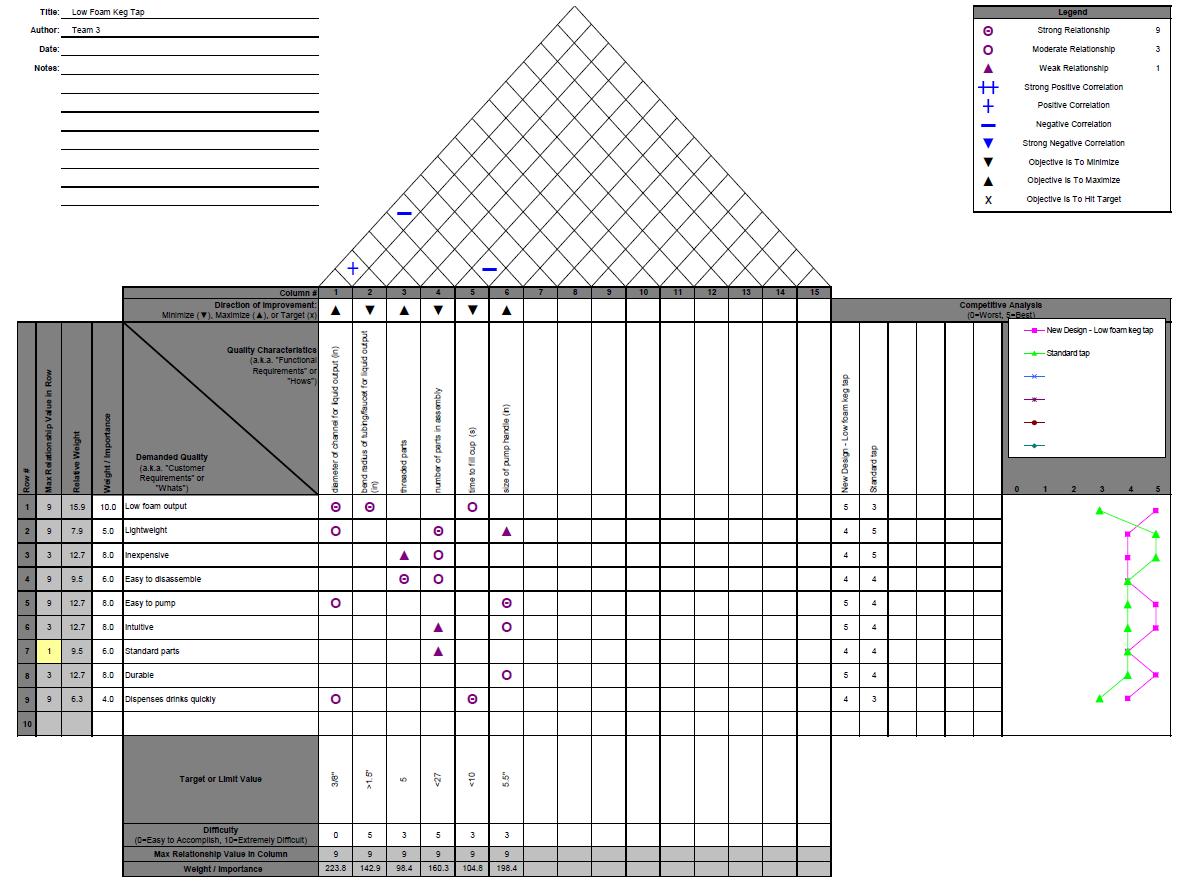
Final Prototype
- Documentation of the final prototype including a discussion of what it demonstrates, what was learned from it, and how it differs from the final design.
Plexiglas is a good material choice for the blade because it is durable, easy to mold, and is resistant to weather conditions. In general, it has 6 to 17 times greater impact resistance than ordinary glass so there is very little chance that the blade will chip or corrode. Plexiglas is well noted for its weather resistance and is commonly used in exterior applications, including the lenses of exterior lights of automobiles. Throughout extended periods of use, plexiglas is not highly susceptible to shrinkage or deterioration. Since our blade obtains a curvature through heat treatment, maintaining this form was initially a concern. However, plexiglas does not become pliable until 180 degrees F, and is not affected by cold temperatures. This also means that the blade will not crack or break due to extreme winter temperatures. To ensure that these properties are true for each blade, testing will be done in extreme weather and temperature conditions, with added weight of debris. For these reasons, our FMEA analysis concludes that plexiglas has a low Occurrence and high Detection value, and has the lowest RPN value despite the high Severity in the rare case of a failure mode.
Testing of Final Prototype
- Documentation of user-testing and user-feedback on your design and prototype.
Testing in snow/ice conditions
User-Feedback
Display
To demonstrate the effectiveness of our wiper attachment for the Design Expo, we created a working model of a windshield wiper. Our display of our final prototype includes the original wiper motor, a single wiper arm, the attachment we designed, and a curved sheet of Plexiglas to represent a windshield.
- picture of complete display*
The windshield wiper motor shown below is from a 1996 Corsica. It is hooked up to a power supply which provides 12 Volts, 3 Amps to the motor. The power output of the motor is 36 watts (36W=12V*3A). Power = Voltage * Current
The picture below is a close-up of the wiring necessary to run the wipers. The black wire is ground, the purple wire supply the motor with power, and the green wire provides the solenoid with power. The solenoid acts as a switch to that allows a continuous rotation of the internal linkages. If this wire is not short circuited, as shown below, the first link will not rotate, and rotation will not be supplied to the wiper arm. Manual activation of this switch is can be viewed by clicking on the link: [2]. In this video, the switch is activated at the beginning and end of the clip. When the solenoid is supplied with power, the black switch is activated (thus putting the purple spring is put in tension) and the internal linkage rotates by fitting in the keyhole of the helical gear. When the solenoid is not supplied with power the internal linkage is fixed, causing a mechanism to snap into the keyhole once per rotation. We believe that this mode is necessary for a storage position of the wipers, causing them to fit under the hood. In actual use, the helical gear would only have one rotation on this this mode and would be activated at the end of wiper use.
As shown in the picture above, the motor translates rotational power to the wiper arms by a combination of a helical and worm gear. This gear train can increase the torque supplied to the wipers as well as slow the output speed to a desirable level. Worms gears are unique in that due to the angle of the teeth they can turn gears, but cannot be turned by other gears. This quality is good for windshield wiper motors because it acts as a locking system, preventing backspin. Helical gears are beneficial in this system because they are more quiet than most gears and are thrust bearing.
Should the design be pursued for production?
- A conclusion of whether or not your design should be pursued for production and why.
Next Steps
- Identification of next steps and any remaining barriers to bringing the proposed design into production.
Team Contributions
- A section on design process and team dynamics that briefly describes the design process path followed by the team and lists semester contributions and team roles from each team member.
Some teams may include additional information, such as a provisional patent draft, optimization results, functional decomposition, VOA, survey results, product family analysis, detailed cost estimation, etc. Each team should identify which aspects are appropriate for making the case for their own product and aim to impress the client with thorough and appropriate work necessary for the client to make a decisions on whether or not to pursue your product further.
References
Java Injection Molding Cost Estimatorv
[[3]]
LanXess websight:
[[4]]
PDF of propties of Lustran ABS 433 when using it for injection molding:
[[5]]
